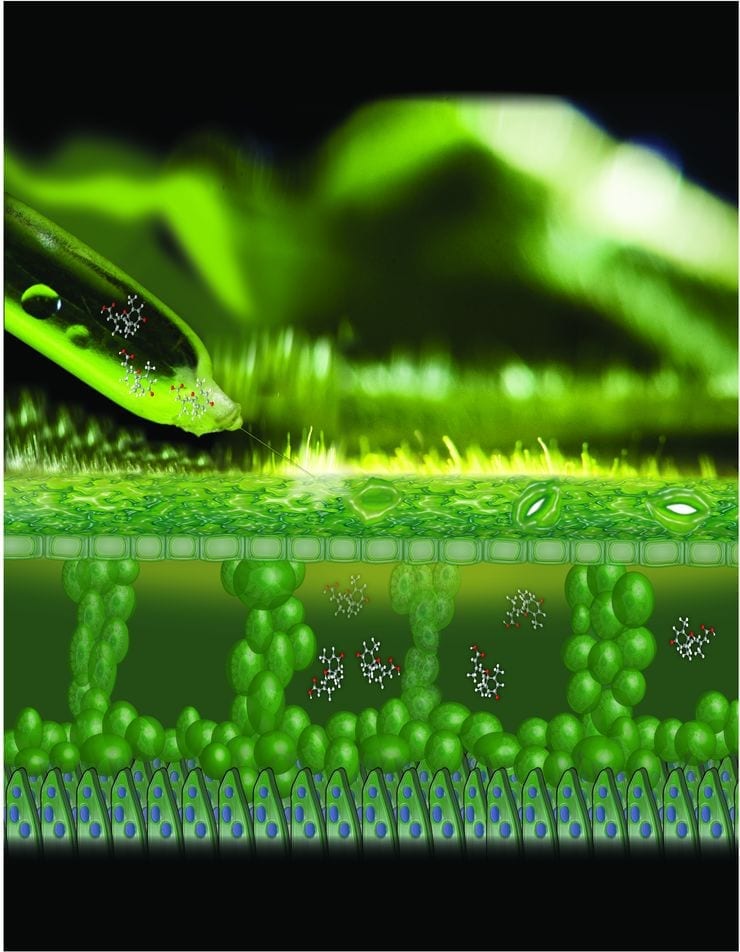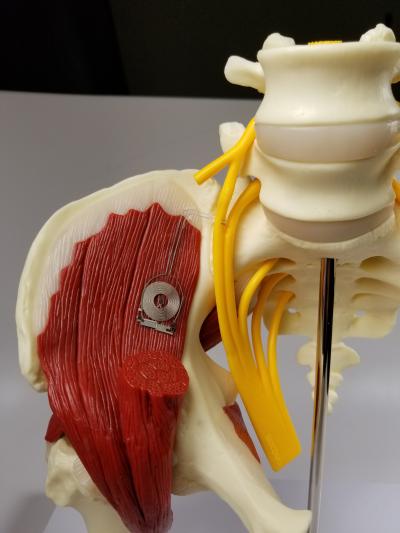
Eleni Stavrinidou and her research group at the Laboratory of Organic Electronics, Linköping University, have used bioelectronics to influence transpiration in a tobacco plant, without harming the plant in any way.
Research in the Electronic Plants group at the Laboratory of Organic Electronics, Campus Norrköping, follows two main avenues. In one, scientists incorporate electronic circuits into plants, such as roses, in a method of storing energy. In the other, they are seeking ways to influence plant functions with bioelectronic devices aiming, for example, to give plants greater resistance to environmental stress.
“We can implant electronic devices into plants without damaging the plant. This research field is new, but we are starting to be able to influence plant physiology, and we hope that this will become an effective tool to study how plants function, but even find applications in agriculture and forestry”, says Eleni Stavrinidou, who leads the research group in Electronic Plants at the Laboratory of Organic Electronics, Linköping University.
Common stress hormone
Scientists Iwona Bernacka-Wojcik and Miriam Huerta have managed to electronically deliver a common stress hormone known as ABA into a tobacco plant. The plant normally secretes this hormone when subjected to stress, for example, during drought or other extreme weather conditions. A solution containing the hormone is also sometimes sprayed onto plants in shops, to keep them fresh longer.
The researchers showed that after the hormone was delivered it spread through the leaf tissue, and that the small pores, the stomata, on the leaf surface closed, to prevent the release of water. The plant must optimise the opening and closing of the pores because when they are open it carries out photosynthesis, but at the same time it loses water.
“Using the new generation of ion pump, with a capillary form whose diameter is no thicker than a hair, we could electronically deliver ABA molecules into the leaves of tobacco plants without harming the plant. If the moisture remains in the plant, it becomes more resistant to, for example, drought”, says Eleni Stavrinidou.
The lack of any damage to the leaf and the plant is an important part of the success, since plants do not repair damaged tissue as animals and humans do. Instead, the plant discards the damaged leaf or branch, and replaces it, in the optimal case, with a new leaf or shoot.
The Ion Pump 2.0
The tiny ion pump was developed a couple of years ago at the Laboratory of Organic Electronics. It consists of an electrode made from a conducting polymer inside a tiny container connected to a channel based on a polymer electrolyte. Ions are led through the thin channel out to exactly the correct position – inside a root fibre or leaf vein of a plant. The container in this case is filled with ABA. When a voltage is applied across the electrodes, one in the container and one external, the charged substance is transported out of the channel into the tissue. The rate of delivery of the substance is directly proportional to the current. Only the active substance is pumped out, nothing else, and there is no return flow to the pump.
“We can give the plant the exact dose it needs, with high precision”, Iwona Bernacka-Wojcik says.
The results from the research – which may also contribute to a deeper understanding of plant physiology – have been published in the journal Small, Advanced Science News.
Learn more: Helping tobacco plants save water
The Latest on: Bioelectronics
[google_news title=”” keyword=”bioelectronics” num_posts=”10″ blurb_length=”0″ show_thumb=”left”]
via Google News
The Latest on: Bioelectronics
- Science Corporation acquires retinal implant from Pixium Visionon April 26, 2024 at 6:39 am
S cience Corporation, a brain-computer interface technology company, has announced the acquisition of intellectual property and related assets for the Prima retinal implant from French bioelectronics ...
- HKU Mechanical Engineering researchers develop miniaturised electric generators based on hydrogels for use in biomedical deviceson April 25, 2024 at 2:00 pm
The development of engineered devices capable of harvesting the body’s mechanical motion and converting it into electricity is crucial for the functioning of bioelectronics.Mechanoelectrical energy co ...
- Understanding Bioelectronics: The Intersection of Biology and Electronicson March 9, 2024 at 4:39 am
Definition: Bioelectronics is an interdisciplinary field that blends biology with electronics, focusing on the development and application of electronic devices and technologies to biology and ...
- Fingerprinting biomolecules with the help of soundon March 4, 2024 at 7:25 am
As they report in the journal Biosensors and Bioelectronics in an article titled "Surface-acoustic-wave-driven graphene plasmonic sensor for fingerprinting ultrathin biolayers down to the ...
- The Shocking Biotech Applications Of Electric Bacteriaon June 24, 2019 at 8:50 pm
These electric filaments could be used for applications such as biosensors and bioelectronics. The filaments could be harnessed as "a revolutionary, sustainably produced, electronic material with ...
- BME 353: Bioelectronicson January 18, 2019 at 2:25 am
BME/MSE 353 covers the materials, device, and some systems level design of bioelectronics for wearable and implantable applications. Significant focus will be placed on the characteristics at the ...
- BioElectronics Corp.on April 16, 2018 at 10:15 am
No significant news for in the past two years. Key Stock Data P/E Ratio (TTM) The Price to Earnings (P/E) ratio, a key valuation measure, is calculated by dividing the stock's most recent closing ...
- Digital health round-up: bioelectronics are closer than you thinkon September 5, 2017 at 5:00 pm
Towards the end of last year, Google's life sciences division Verily and GlaxoSmithKline co-founded Galvani Bioelectronics to develop medicines that harness electrical signals in the body to ...
via Bing News










